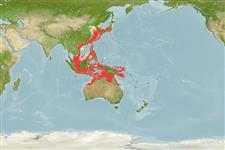Elasmobranchii (Haie und Rochen) (sharks and rays) >
Heterodontiformes (Bullhead and horn sharks) >
Heterodontidae (Bullhead, horn, or Port Jackson sharks)
Etymology: Heterodontus: heteros (Gr.), different; odontos (Gr.), tooth, referring to pointy teeth (for clutching prey) at front of jaws, different than rounded molar-like teeth (for grinding hard-shelled invertebrates) at the back. (See ETYFish); zebra: Referring to 12 narrow brown or black zebra-like stripes on body. (See ETYFish).
More on author: Gray.
Environment: milieu / climate zone / depth range / distribution range
Ökologie
seewasser riff-verbunden; tiefenbereich 0 - 200 m (Ref. 6871). Subtropical; 40°N - 20°S, 103°E - 155°E
Western Pacific: Japan to northwestern Australia (Ref. 6871) and Queensland.
Length at first maturity / Size / Gewicht / Alter
Maturity: Lm ?, range 84 - ? cm
Max length : 125 cm TL Männchen/unbestimmt; (Ref. 2334)
Rückenflossenstacheln (insgesamt): 2; Rückenflossenweichstrahlen (insgesamt): 0; Afterflossenstacheln 0; Afterflossenweichstrahlen: 0. The Zebra bullhead shark, Heterodontus zebra, has a large blunt head, low supra-orbital crest gradually sloping behind eyes, dorsal fin spines, anal fin, and zebra-pattern of dark, narrow vertical bands on a pale background (Ref. 9838; 6871). As characteristic of members of the family, caudal fin with a moderately long dorsal lobe and moderately long ventral lobe, the latter shorter than the dorsal lobe, vertebral axis raised into caudal-fin lobe (Ref.9838).
A common but little-known shark found on the continental and insular shelves in depths down to at least 50 m (Ref. 247, 11230) in the South China Sea, but deeper and in 150 - 200 meters off Western Australia (Ref. 43278). Probably feeds on bottom invertebrates and small fishes (Ref. 6871). Oviparous (Ref. 247).
Oviparous, paired eggs are laid. Embryos feed solely on yolk (Ref. 50449). Distinct pairing with embrace (Ref. 205). Lays auger type eggs (about 12-18cm, 4.7-7 inches long) among rocks & kelp, often with more than female using same oviposition site, with as many eggs found in a single nest; female lay 2 eggs at a time, from spring to late summer in Japan, 6-12 times during a single spawning season. Eggs hatch in 1 year. Hatch at 18 cm (7 inches), max length at 1.2m (3.9 ft.). During courtship, male grasps pectoral fin of female & wraps posterior part of body under her so single clasper can be inserted into her cloaca. In several mating bouts observed, copulation lasted as long as 15 minutes (Ref. 12951).
Compagno, L.J.V., 2001. Sharks of the world. An annotated and illustrated catalogue of shark species known to date. Vol. 2. Bullhead, mackerel and carpet sharks (Heterodontiformes, Lamniformes and Orectolobiformes). FAO Spec. Cat. Fish. Purp. 1(2):269 p. FAO, Rome. (Ref. 43278)
IUCN Rote Liste Status (Ref. 130435)
Bedrohung für Menschen
Traumatogenic
Nutzung durch Menschen
Fischereien: weniger kommerziell; Aquarium: Potenzial
Mehr Information
ReferenzenAquakulturAquakultur ProfilZuchtlinienGenetikElectrophoresesVererbbarkeitKrankheitenVerarbeitungNutrientsMass conversion
Tools
Zusatzinformationen
Download XML
Internet Quellen
Estimates based on models
Preferred temperature (Ref.
123201): 15.4 - 26.6, mean 21.8 °C (based on 223 cells).
Phylogenetic diversity index (Ref.
82804): PD
50 = 0.5059 [Uniqueness, from 0.5 = low to 2.0 = high].
Bayesian length-weight: a=0.00380 (0.00166 - 0.00872), b=3.15 (2.95 - 3.35), in cm total length, based on LWR estimates for this (Sub)family-body shape (Ref.
93245).
Trophic level (Ref.
69278): 4.0 ±0.66 se; based on food items.
Widerstandsfähigkeit (Ref.
120179): niedrig, Verdopplung der Population dauert 4,5 - 14 Jahre. (Fec assumed to be <100).
Fishing Vulnerability (Ref.
59153): High to very high vulnerability (75 of 100).
